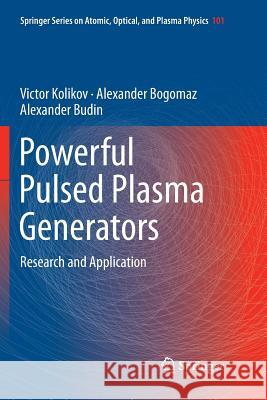Powerful Pulsed Plasma Generators: Research and Application » książka



Powerful Pulsed Plasma Generators: Research and Application
ISBN-13: 9783030070007 / Angielski / Miękka / 2019 / 250 str.
Powerful Pulsed Plasma Generators: Research and Application
ISBN-13: 9783030070007 / Angielski / Miękka / 2019 / 250 str.
(netto: 499,55 VAT: 5%)
Najniższa cena z 30 dni: 501,19 zł
ok. 22 dni roboczych
Bez gwarancji dostawy przed świętami
Darmowa dostawa!
1.Introduction……….………………………………...................….………………….. 14
References……………………………………………………………………………... 21
2 Test Benches of the IEE RAS’ Pulsed Plasma Generators..…................................. 25
2.1 Construction and Equipment of Test Benches………….....……......................... 25
2.2 Power Supplies of the Plasma Generators.……..……………….......................... 26
2.2.1 Capacitive Power Supply CPS-25……………………………………... 26
2.2.2 Capacitive Power Supply CPS-10……………….…….......................... 32
2.3 Components of Power Supply………..…………….………..……….………… 36
2.4 Diagnostic Methods and Measurement Equipment..…………...………………. 39
2.4.1 Initial Parameters of Experiment…….………………….……………... 39
2.4.2 Pulsed Current…..…………….…………….…………...…………….. 40
2.4.3 Voltage Drop Across Arc……....…………………...…..…………….. 41
2.4.4 Pulsed Pressure……….……………………………………………….. 42
2.4.5 Optical Registration…….……………………………………………… 44
2.4.6 X-Rays Registration…………………………………………………… 46
2.4.7 Data Registration and Processing System…………....….…………….. 48
References……………………………………………………….……………….……. 49
3.Pulsed Plasma Generators……………………………………………………………………..51
3.1 Types of Electrodischarge Chambers………………..………....……………….. 51
3.2 IEE RAS’ Pulsed Plasma Generators………………….……….………………. 57
3.2.1 Design of Plasma Generators………….……………...…….................... 57
3.3 Components of Plasma Generators’ Electrodischarge Chambers…..….………. 66
References………………………………………………………..….………………… 75
4 Parameters of the Arc..…..….....…………………………..…..……………………. 77
4.1 Resistance……..…………….….………….……..……...……………………… 77
4.2 Electric Feld Intensity in Generator PPG-3…………………………………….. 83
4.3 Current Density………………………………….………................................... 90
4.4 Inductance…………………..……..…………..……….…………………...…... 90
4.5 Temperature..……………..……………….……………….…………………..... 91
References………………………………………………………….………………...... 94
5.Erosion of Electrodes………...………………………………...…….……………..…. 96
5.1 Specific Erosion of Electrodes.………………………………………………………....96
5.2 Liquid and Vapor Erosions.…………….……………….……..……..………. 101
5.3 Erosion as Electrode Jets…..………………..….…………….……………….. 1075.4 Erosion as Electrode Surface Layer Ejection…………….…...…….…………. 111
5.5 Erosion and Molecular Weight of Gas……..………………............................. 114
References………………………………………………………….………………... 1166 Oscillations of Arc’ s Diameter……………….……………………......................... 118
6.1 Acoustic Oscillations……………………….…...……..……….……………... 118
6.2 Shock-Wave Compression of Arc..………….……….…..….….…………….. 122
6.3 Oscillations of Arc’s Diameter Caused by Magnetic and Gas Pressures……… 125
6.4 Oscillations of Soft X-Rays Irradiation Intensity……………………………... 126
References………………………………………………………….………………... 130
7 Processes and Heat Transfer in Electrodischarge Chamber.....………..……….. 131
7.1 Arcing in Coaxial Discharge Chamber……………….…………..................... 131
7.2 Arc Movement…………………...…….……………..……….….…………… 137
7.3 Heat Transfer from Arc to Gas………………………………….…………….. 141
7.3.1 Irradiation…………………………………………….....…………… 141
7.3.2 Thermal Conductivity…………….……………………..…………… 143
7.3.3 Turbulent Heat Transfer…………..………………….….…………… 1447.3.4 Shock Waves………..…………………………………….................. 145
7.3.5 Shock Waves in Hydrogen….……………………….………………. 146
7.3.6 Shock Waves in Helium..……………………….…………………… 146
7.3.7 Shock Waves in Air……….………………………….……………… 150
7.3.8 Impact of Electrode Jets on Heat Transfer………..……..…………… 152
7.4 Energy in Arc and Heat Transfer Components…..………...…………………. 156
References…………………………………………………………….……………... 157
8 Modes of Arcing………………….……………………………..….………………. 159
8.1 Arc at Refractory Electrodes………...……………………...…….................... 159
8.2 Arc at Fusible Electrodes……………...…………………………..................... 163
8.3 Multipulse Mode……………….……………….……………………………... 164
8.4 Two-Arc Mode………………………..…..…………………………………… 166
8.5 Programmable Mode……………………….…………………..……………… 168
References………………………………………………..………………………….. 171
9 Arc Contraction. Modified Current of Piza-Braginskii………………………….. 172
9.1 Arc at Initial Hydrogen Pressure of 5 MPa…………………………………... 172
9.2 Discharge in Helium……………………..……............................................... 177
9.3 500 kA Arc at Tungsten Electrodes……..……………………………………. 180
9.4 1.6 MA Arc at Steel Electrodes……………………………………………….. 185
9.5 Soft X-Rays Irradiation………………………………….…….……………… 188
9.6 Heating of Hydrogen by X-Ray Irradiation….....…………………………….. 189
9.7 Arc Glow Change at Contraction…….…………...…….……........................ 191
References………………………………………………………….……….……….. 191
10 Arc at Ultrahigh Pressure….………………...………………….…………………. 194
10.1 Arc in Pre-Compressed Gas………………...………………........................... 19410.2 Arc at Current of 220 kA………...………….……………...………………... 201
10.3 Arc at Current of 500 kA.…..………………..…………….…………….….. 207
10.4 Arc at Current of 2 МА.……………………………………...……………… 212
10.5 Critical Pisa-Braginskii Current………..……….……………..……………. 213
References………………………………………………………….………………... 220
11 Energy Features of Plasma Generator………………………..………….……….. 223
11.1 Energy Transfer Coefficients…………………………..…......……………... 223
11.2 Simulation of Plasma Generators Processes.………………….…………….. 228
References………………………………………………………….………………... 230
12 Applications of Pulsed Plasma Generators……………………………………….. 231
12.1 Application of Plasma Generators in Scientific Researches…………………. 231
12.2 Application of Plasma Generators for Toxic Substances Destruction…….… 233
References………………………………………………………….………………... 235
Index……………………………………………………...…………….….......................... 236
V. Kolikov: has been working at the Institute for Electromechanics, Academy of Science of USSR (now the Institute for Electrophysics and Electric Power, Russian Academy of Science) since 1967, first as a Laboratory Assistant and now as Vice Director. He has published 159 papers and one book, and holds five patents. In 2005 he received his Science Doctor Degree from the IEE RAS.
A. Bogomaz: was born in Leningrad, USSR in 1943. He graduated from the Physical Faculty of Leningrad State University in 1967 and completed his Ph.D. in electrophysics at the Institute of Problems of Electrophysics (St.-Petersburg) in 1981. Now he is a leading researcher at the Institute for Electrophysics and Electric Power, Russian Academy of Sciences (IEE RAS, St. Petersburg). He is the author or co-author of more than 100 papers. His chief scientific interests are in the electrical technology and physics of high-current discharge in high and ultrahigh pressure gas.
A. Budin: was born in Frankfurt on Oder, Germany, in 1956. He received his M.S. degree from Leningrad Polytechnic Institute, Russia in 1979 and his Ph.D. degree in electrophysics from the Institute of Problems of Electrophysics in 1997. He is currently head of the laboratory at the Institute for Electrophysics and Electric Power, Russian Academy of Science. His main areas of scientific activity are the physics of high current arc discharges in dense gas media, electrodischarge accelerators and hypervelocity impact, pulse plasma generators and pulse power sources. He is the author or co-author of more than 160 papers.
This book presents experimental and theoretical results on extremely powerful plasma generators. It addresses pulsed electrical mega-ampere arcs and the mechanisms of energy transfer from the arc into hydrogen, helium and air under pressures up to 250 MPa and currents up to 2 MA. Extreme plasma parameters and increased energy density in the arc were achieved. It was found experimentally that increasing the initial gas pressure to hundreds of MPa leads to improved arc stability, high efficiency of energy transfer from arc to gas, and plasma enthalpy growth. The data obtained data provides the basis for the development of electrophysical devices with high energy density, e.g. high intensity sources for visible, UV and X-ray irradiation for laser pumping, generators of high enthalpy plasma jets, and plasma chemical reactors.
1997-2025 DolnySlask.com Agencja Internetowa
KrainaKsiazek.PL - Księgarnia Internetowa









